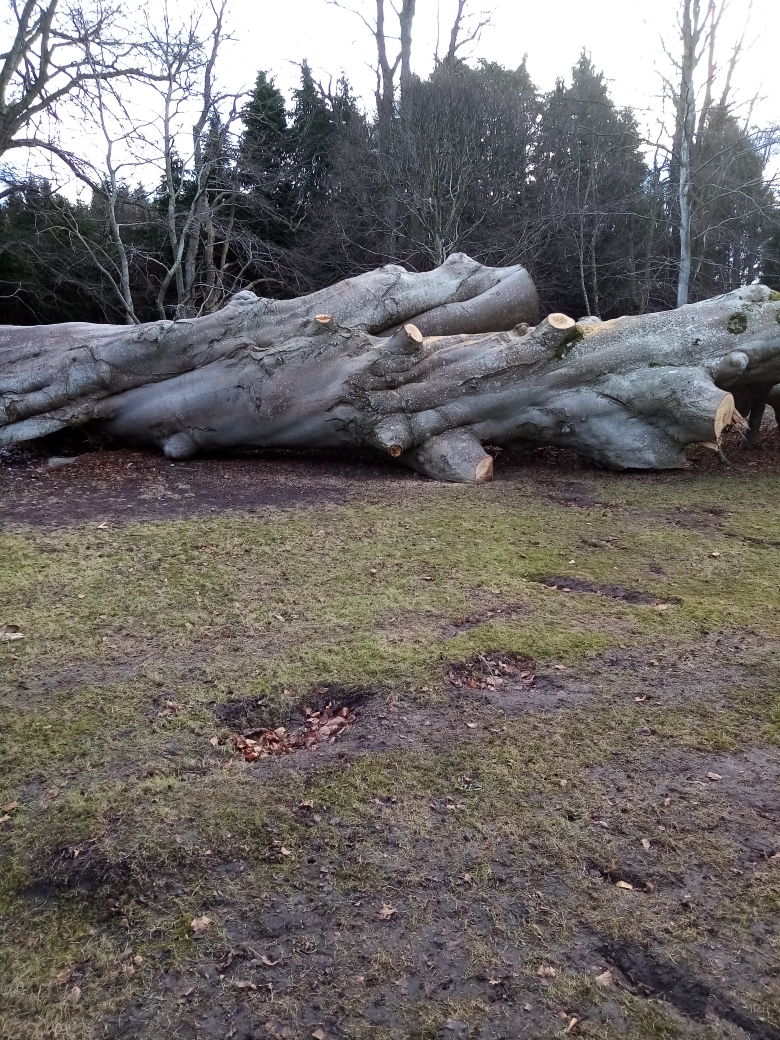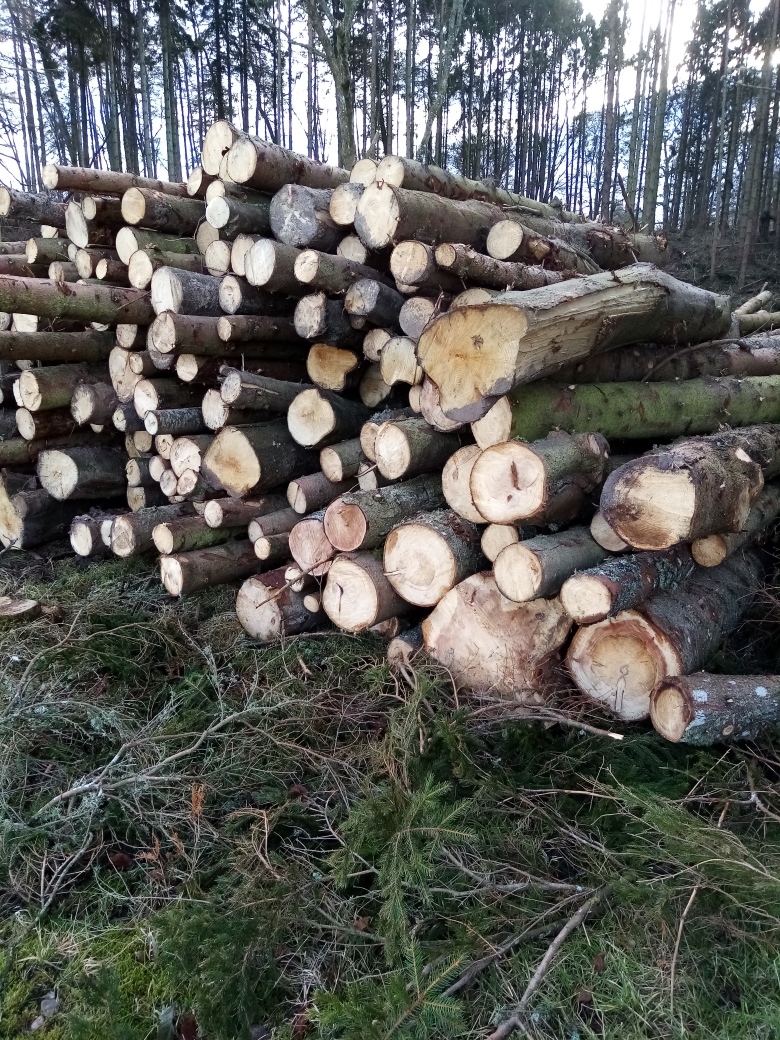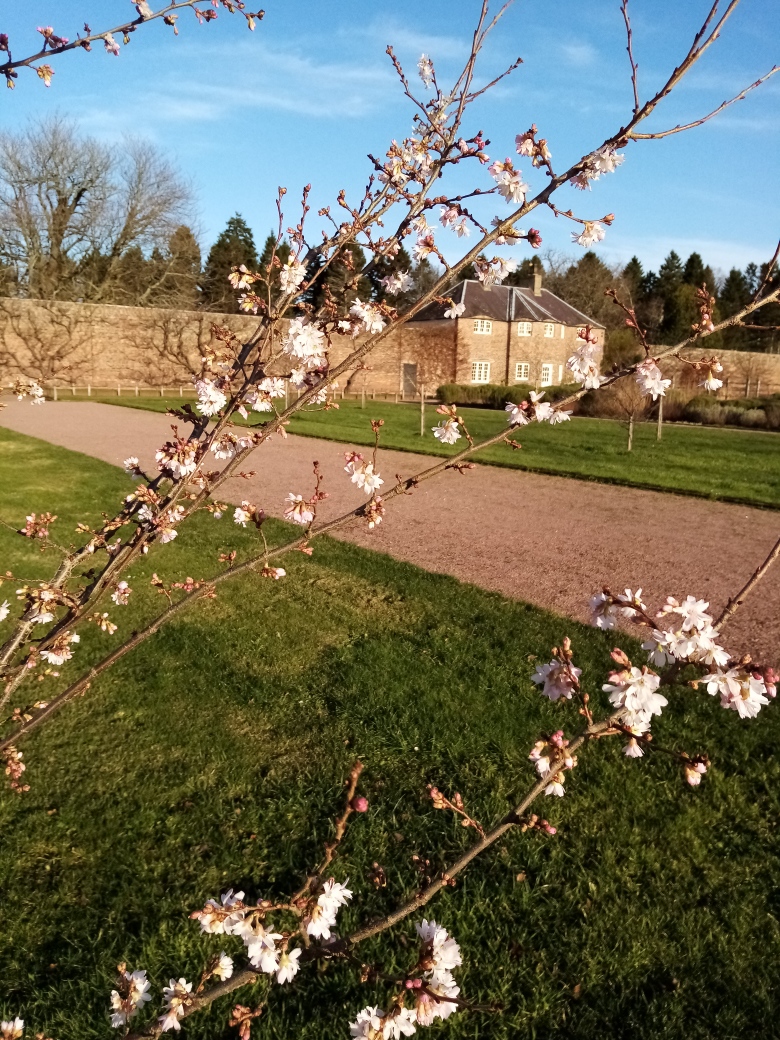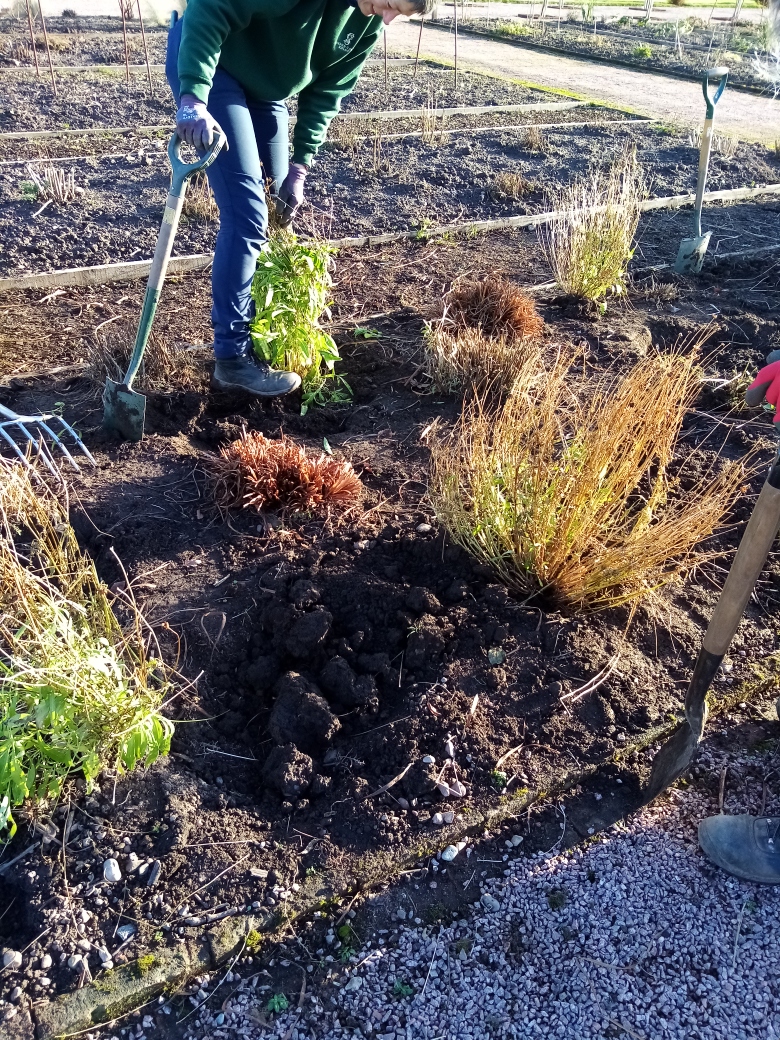Drive over the bridge into the estate, take a moment, slow down, look right… Reclining on its grassy couch lies the trunk of an ancient beech without doubt over 300 years old, a mother tree which survived wars and storms, a symbol of permanence. Sadly its aged hollow trunk was no match for storm Arwen; now she is at rest watching over her domain, as magnificent in her demise as she was in life.
In the aftermath of storm Arwen Gordon Castle estate has lost countless trees. Many bordering the road approaching the gardens are gone, leaving standing timber punctuated by neat piles of sawn logs and branches. The fishing season is upon us so the ghillies, who did such a sterling job helping to clear storm debris, are now back at work on the River Spey. Specialists will be required to attend to the few potentially dangerous rogue trees.


Drive through bright dappled low winter sun glancing through the remaining trees to find the garden, unscathed, sheltered behind high brick walls. However with the loss of so much forestry it is now possible to see the castle tower from the south west corner. Come visit and see! From a distance the tower looks as if it is level with the garden; I wonder what one can now see from the top of that same tower?
An unusually mild January this year, but, no matter, the first job is ‘pruning!’ The soft fruit area has already been done weeded and tidied, next come the rose bushes. Then a month of pruning the trained fruit trees; apples, plums and pears. At the time of writing mild conditions prevail however frosty weather can be an advantage; at this time of the year who knows what the weather will do? Pruning is essential to keep the structure and shape of the trees so they stay healthy and bear a good fruit crop later in the year.
Some of the larger perennials have been divided and replanted in the borders.
Then to cultivation! Twenty tons of well rotted horse manure lies waiting to mulch the vegetable beds, eventually it will be ploughed into the soil. Ed prefers horse manure because it appears to contain less unwanted plant seeds. The addition of this organic matter makes a big difference to the soil providing nitrogen, improving soil structure while retaining water and nutrients. ‘The secret is in the soil!’


January is an exciting ‘deciding’ time. What shall we grow this year?
Plans are in place to grow at least twenty varieties of colourful dahlias, the tubers arrive soon to be potted up in March, brought on in the greenhouse and planted out later in the year.
Seed lists of vegetable and cut flower varieties are being compiled ready to order by the first week of February.
There are plans to join the Heritage seed library by growing heritage plants, saving the precious seeds to send to the library which helps conserve vegetable varieties that are not widely available.
Joining the usual well known potato varieties are three heritage ones which will be clearly marked – Belle de Fontane, Foxton and Carolous.
The Heirloom vegetables which Liz is planning to grow in the trial bed come with some intriguing names.
Beetroot – Egyptian turnip rooted
Cabbage – golden acre
Cauliflower – dwarf erfurt
Carrot – Jaune du Doubs
Onion – white Lisbon
Turnip – Veitch’s red globe
Parsnips – Hollow crown
Radish – long white icicle
Sweetcorn – Stowell’s evergreen
All will be planted in clearly labelled rows. I cannot wait till they are ready to harvest because it will be interesting to find out how they cook and taste! A long time ago someone developed these vegetables to meet the palate of the time. I wonder how we shall find the flavour!
Learn how to grow your own.
Grow your own courses for vegetables and cut flowers will be delivered at the gardens and online in March and April and more details will be available soon.
Click here for more information.
Platinum jubilee events to celebrate the Queen’s special year are being prepared– more details to follow.
Plot to plate in June and July
An exciting new initiative championed by Moray Food Ambassador Ghillie Basan.
Enjoy a tour of the garden collecting fresh garden produce with head gardener Ed Bollom. Watch as our resident chef transforms the freshly picked fruit and vegetables into a delicious lunch while relaxing with a glass of one of Gordon Castle’s iconic brews! A fantastic day out.
Date for your diary!
Have fun at the popular Highland Games on 15th May 2022. The garden will have their popular stall of plants for sale. The restaurant is open Wednesday to Sunday from 11am till 4 pm serving freshly cooked dishes using fresh garden produce where possible. There are still leeks, chard, potatoes, kales, cabbage and sprouts in the garden and you will find them on sale at the Potting Shed. Jerusalem artichokes too, they are good this year available to order in advance.
GLAN’S JERUSALEM ARTICHOKE SOUP
My friend Glan makes this delicious recipe each year.
Serves 4 people
400gms( 14oz) Jerusalem artichokes scrubbed, trimmed and chopped
150gms( 5 ½ oz) potatoes peeled and chopped
60gs (2oz) unsalted butter
500mls (16 fl oz) vegetable stock
½ teaspoon fresh lemon thyme or garden thyme ( or ¼ teasp dried)
Zest and juice of half a lemon
Melt the butter over a low heat and gently sweat the artichokes and potatoes for 10 minutes with a lid on the pan. Add stock, thyme and lemon zest. Simmer 20 minutes till the vegetables are tender ( make sure the potatoes are soft or they will be gluey when pureed). Add lemon juice and season to taste. Blend till smooth. Serve hot.
Now some home bakes for cold winter days.
BUMPY ROAD FLAPJACKS
125g (4 ½ oz) butter
30g (1oz) honey or golden syrup
115g (4oz) soft brown sugar
125g (4 ½ oz) self raising flour
115g (4oz) porridge oats
Handful of mini-marshmallow
Handful of chocolate chips
Heat the oven to 160C (140C fan) 325F, Gas 3. Oil and line a baking tray approx 20cm x 25cm (8x10in). Melt the butter, honey and sugar in a pan till warmed but not boiling. Mix the flour and oats in a bowl. Stir in the melted ingredients. Scatter half roughly over the base of the tin. Scatter with the marshmallow and chocolate then cover with the rest of the mixture and press lightly together. Bake for 20 minutes no longer or the mixture will become rather crisp. Cool in the tin and mark into squares while warm.
Kindly written by Liz Ashworth for Gordon Castle Walled Garden
